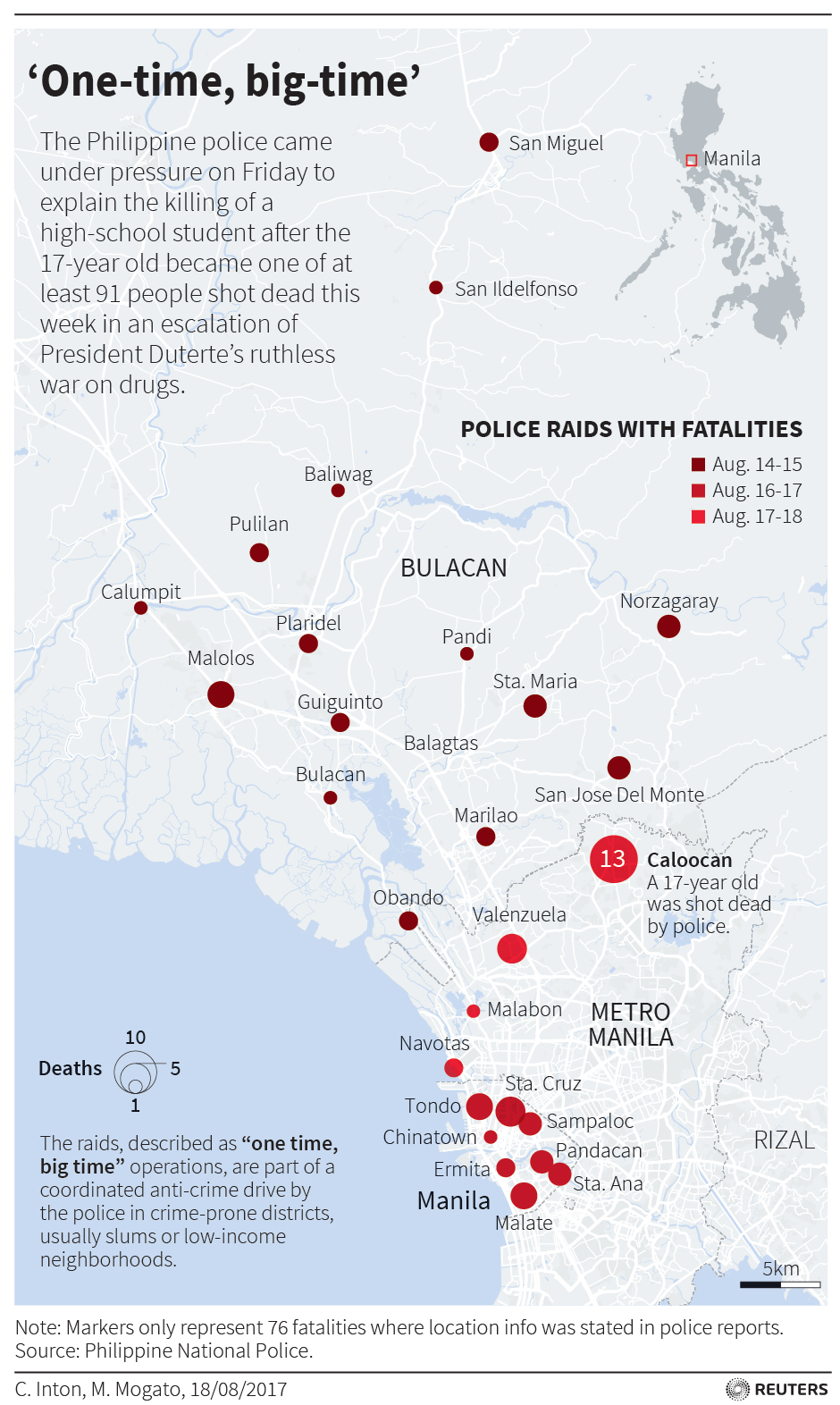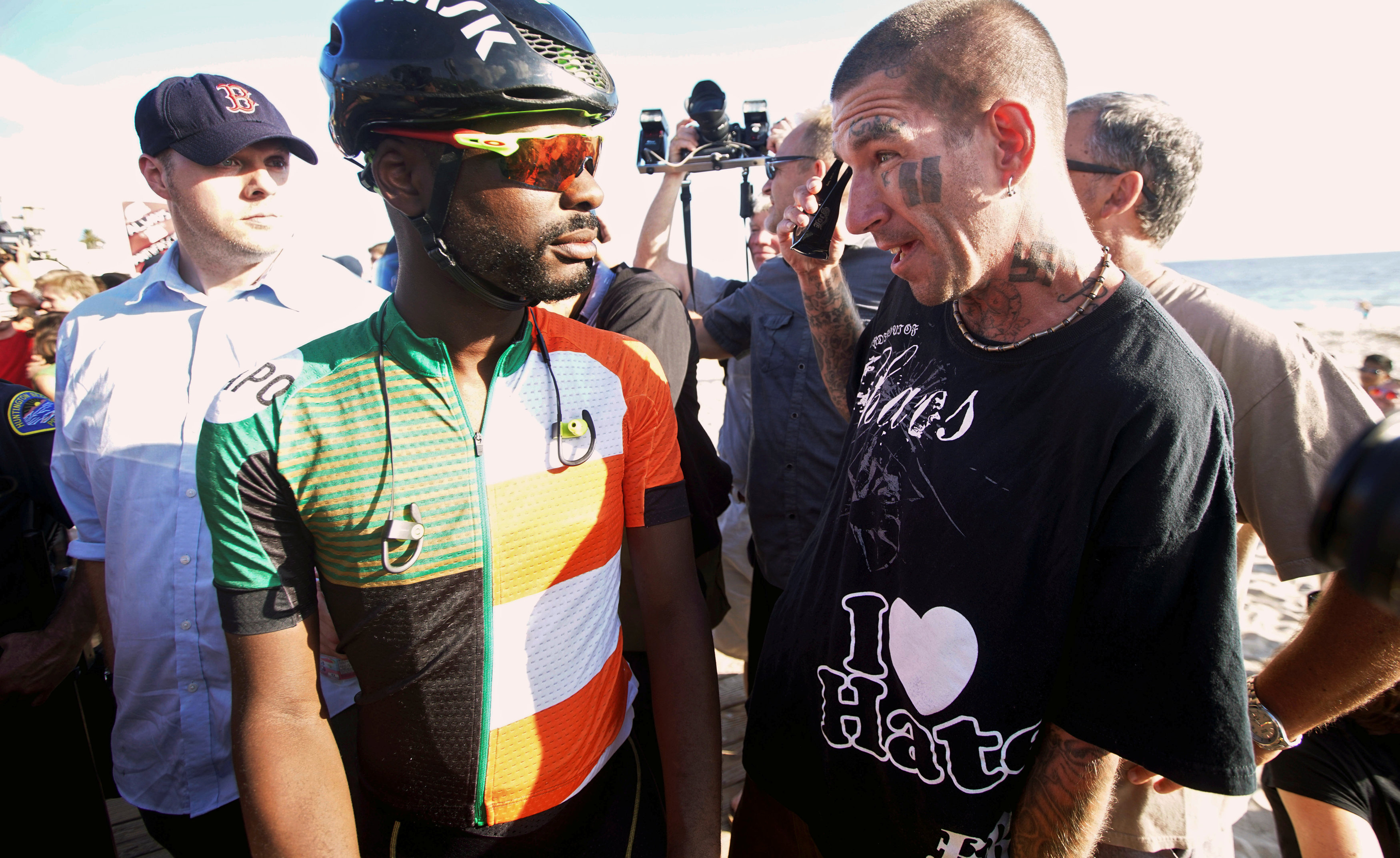
By Andrew R.C. Marshall and Neil Jerome Morales
MANILA (Reuters) – Philippine teenager Kian Loyd delos Santos told friends he dreamed of becoming a policeman after graduating from high school.
Last week, plain-clothes policemen dragged the 17-year-old to a dark, trash-filled alley in northern Manila, shot him in the head and left his body next to a pigsty, according to witnesses whose accounts appeared to be backed up by CCTV footage.
The killing has electrified the Philippines, sparked multiple investigations and galvanized what had previously been limited opposition to President Rodrigo Duterte’s war on drugs. Thousands of people have been killed since he took office 14 months ago.
Police said they shot delos Santos in self-defense after he opened fire on officers during an anti-drugs operation. But there was outrage when the CCTV footage emerged showing two officers marching a figure, subdued and apparently unarmed, toward the spot where the youth’s body was later found.
Three officers, who police say have been confined to quarters in a Manila police camp, are now defending their actions in a Senate inquiry that began on Thursday. They maintain delos Santos fired at them.
The teenager’s parents and the Philippines Public Attorney’s Office, a government legal aid agency, have filed murder charges against the policemen at the justice department.
“Let us allow the formal criminal investigation to proceed and not rush into conclusion or judgment. Let us allow the personnel involved to have their day in court and defend themselves,” Philippines National Police spokesman Dionardo Carlos said when asked about the case.
Reuters journalists spoke to at least two dozen witnesses, friends and neighbors of delos Santos in Manila’s Caloocan area about his killing.
They said he was a kind, popular teenager who liked to joke around and didn’t drink or do drugs. He was too poor to own a gun, they said.
“We no longer have our joker,” said one of his friends, Sharmaine Joy Adante, 15.
She said delos Santos had wanted to join the police so that his mother, who works in Saudi Arabia, could afford to live in her own country.
Nearby, at the entrance to his family’s tiny home, delos Santos lay in an open coffin. Among the tributes placed on its lid was a crumpled playing card – a joker – and a live chick to symbolically peck away at the conscience of his killers.
Some locals said they feared reprisals from the police for speaking out and asked Reuters to withhold their second names.
SLAPPED, PUNCHED, PUT IN A HEADLOCK
It was after 8 p.m. on August 16 when Erwin Lachica, 37, a welder, said he saw three men in civilian clothes enter the area on two motorbikes. All three had handguns tucked into their waistbands, he said.
Lachica recognized them as officers from previous police operations in the neighborhood. They were later identified as Arnel Oares, Jeremias Pereda and Jerwin Cruz.
According to a police report issued a day after the killing, when the teenager saw officers approaching, he immediately drew a weapon and shot at them. Oares, who led the operation, returned fire and killed him, it said.
“It was dark, he fired at us,” Pereda told the Senate inquiry this week. “We knew it was a gun, there was a loud sound. We saw a gleam of light.”
Police have cited self-defense as the pretext for killing more than 3,500 people in drug-war operations since Duterte came to power.
Lachica had a different version of events. He said delos Santos was standing outside a shop when the men grabbed him, and then slapped and punched him until he started crying. No gunbattle took place, he said.
“He was saying he was innocent, he was not a drug addict,” added Lachica, who said the men put delos Santos in a headlock and dragged him away.
CCTV footage from a neighborhood security camera shows two men marching someone, his head bowed, through a nearby basketball court. A third man follows.
The officers told the Senate that they were indeed in the video but were bundling away an informant, not delos Santos. Multiple witnesses, however, told Reuters they recognized the youth.
One of those witnesses was Victor, a teenage student, who said he knew delos Santos because he lived in the neighborhood. He said the men hustled delos Santos across the basketball court and down a path to the filthy, flood-prone Tullahan River.
Victor dared not follow. “We were very scared,” he recalled, his eyes filling with tears.
Delos Santos’ life ended in a dark nook next to a disused pigsty by the river. A few paces away, a 39-year-old construction worker called Rene was eating dinner with his two daughters in his home.
First, said Rene, he heard shouting – a man ordering residents to stay inside their houses – then two bursts of gunfire, perhaps 10 shots in all.
“We hid under the table,” he said. “We didn’t even peek out the window.”
Three other residents told Reuters they heard between seven and nine shots. Others said they heard nothing at all: Manila slums are seething, raucous places, where even gunfire can be drowned out.
KILLING STRIKES A CHORD
Autopsies by the police and the Public Attorney’s Office disagreed on the number of gunshot wounds delos Santos sustained, but pathologists for both told the Senate that he was kneeling when shot.
“You are not allowed to kill a person that is kneeling down begging for his life. That is murder,” Duterte said in a speech on Wednesday.
Duterte’s supporters have taken to blogs and social media to express support for the police and raise doubts about delos Santos’ innocence.
But the killing appears to have kindled grave concerns among the public because of the age of the victim and because the video supported witness accounts of his killing.
It has also fueled longstanding public anxiety about the drug war’s brutal methods, and could generate wider opposition to a campaign whose critics have so far been largely limited to priests, activists, lawyers and a handful of prominent politicians.
Still, Duterte remains popular, said Ramon Casiple, executive director of the Manila-based Institute for Political and Electoral Reform.
“It’s not really a tipping point,” he said. “But Duterte is vulnerable. His popularity will take a hit.”
Delos Santos’ death was the culmination of a spike in killings across the Philippines’ main island, Luzon.
That same night, police shot dead at least 28 people in Manila during multiple operations to crack down on drugs and crime. Two nights before that, in Bulacan province, just north of the capital, police killed 32 people.
Some rights activists saw the upsurge as a government bid to regain credibility lost after Duterte’s recent admission that no president could solve the drug problem in a single term. He had originally vowed to end it within six months of taking office.
Many critics question the drug war’s focus on killing petty users and dealers from poor communities, rather than nabbing the kingpins who supply them with crystal meth, a highly addictive stimulant known locally as ‘shabu’ that officials blame for high crime rates and other social ills.
In a speech this week, Duterte said he had told his police chief to jail the officers involved in the delos Santos killing until an inquiry was conducted. He also vowed to continue the drug war.
“If you want, shoot me. But I will not change my policy,” he said later.
Presidential spokesman Ernesto Abella told Reuters that there were lessons to be learned from the events.
“Kian’s case is a wake-up call for the need to reform government institutions, even law enforcement agencies,” he said.
For a graphic on death of a schoolboy, click: http://fingfx.thomsonreuters.com/gfx/rngs/PHILIPPINES-DRUGS/010050JX18M/index.html
(Additional reporting by Karen Lema, Manuel Mogato and Chin Samson; Editing by John Chalmers and Raju Gopalakrishnan)












